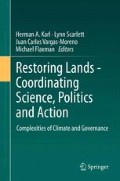Abstract
Over the past century, public land management has unfolded as a saga of tensions and challenges at the delicate interface of people and place. Many of these challenges test the endurance of our governing institutions. An institutional discovery process is unfolding with the emergence of new forms of governance – the rules and processes by which formal and informal groups of people make decisions regarding matters in which they have intersecting responsibilities and interests. Networks, collaboration, shared stewardship, and partnerships characterize these new forms of governance. These emergent collaborative endeavors are creating new bundles of ownership rights through easements, contracts, compacts, and cooperative agreements. Lying as a backdrop to the emergence of these new forms of governance are four policy and decision making puzzles. These include information challenges, incentive challenges, accountability challenges, and coordination challenges. Examining examples of network governance illuminate how they address these four decision making challenges and their implications for law, policy, and management skills.
Access this chapter
Tax calculation will be finalised at checkout
Purchases are for personal use only
Notes
- 1.
Cooperative Conservation America web site: http://www.cooperativeconservationamerica.org/viewproject.asp?pid=490. Accessed 29 Aug 2010.
- 2.
Communication with the author, 2002.
- 3.
The information presented here on Buffalo Creek, Pennsylvania comes from an author site visit in 2002.
- 4.
See the Cooperative Conservation America web site at: http://www.cooperativeconservationamerica.org/viewproject.asp?pid=127. Accessed 29 Aug 2010.
- 5.
Information is from a site visit by the author (2002) and from: http://www.doi.ogv/partnerships/ducktrap.html and http://www/coastalmountains.org/protecting_land/active_campaigns.html#ducktrap.
- 6.
Information comes from site visits by the author in 2003, 2007, and 2010. Other information can be accessed online at: www.malpaiborderlandsgroup.org
- 7.
Information results from a site visit by the author in 2009. Information can also be obtained at: http://www.blm.gov/wo/st/en/prog/more/partnerships_home/tools/case_studies/sonoita.html. Accessed 29 Aug 2010.
- 8.
Communication with the author, 2002.
- 9.
Unpublished document, distributed at the National Conference on Ecosystem Restoration, Los Angeles, CA 2009, available from Lynn Scarlett at lynnscarlett@comcast.com.
References
Ball J (1997) On the urban edge. J For 95(10):6–10
Boesch D, Goebel M, Ogden J, Scarlett L (2009) Ecosystem restoration at a landscape-scale: governance characteristics. Presented at national conference on ecosystem restoration, Los Angeles. Available from Lynn Scarlett at scarlett@rff.org
Brick P, Snow D, Van De Wettering S (eds) (2001) Across the great divide: explorations in collaborative conservation and the American West. Island Press, Covelo
Brunner et al (2002) Finding common ground: governance and natural resources in the American West. Yale University Press, New Haven
Emerson K, Nabatchi T, Balogh S (2011) J Public Adm Res Theory
Goldsmith S, Kettl DF (eds) (2009) Unlocking the power of networks: keys to high-performance government. Brookings Institution Press, Washington, DC
Klamath Agreement (2010) Available at http://klamathrestoration.gov/keep-me-informed/klamath-agreements
Goldsmith S, Eggers WD (2004) Governing by network: the new shape of the public sector. Brookings Institution Press, Washington, DC
Hilborn RC (2004) Sea gulls, butterflies, and grasshoppers: a brief history of the butterfly effect in nonlinear dynamics. Am J Phys 72:425–427
Isaacs W (1999) Dialogue and the art of thinking together. Doubleday, New York
Koontz et al (2004) Collaborative environmental management: what roles for government? Resources for the Future, Washington, D.C
Landry R, Amara N, Lamari M (2001) Utilization of social science research knowledge in Canada. Res Policy 30:333–349
Lawton JH (2007) Ecology, politics and policy. J Appl Ecol 44:465–474
McHenry MG (2003) The worst of times: a tale of two fishes in the Klamath Basin. Environ Law 33:1019–1058
McKinney M, Scarlett L, Kemmis D (2010) Large landscape conservation: a strategic framework for policy and action. Lincoln Institute of Land Policy, Cambridge
Melvin E, Dietrich K, Wainstein M (2005) Solving seabird bycatch in Alaska fisheries: a case study in collaborative research. Washington Sea Grant Program, Seattle. Available at www.wsg.washington.edu
National Research Council (2003) Science and the greater everglades ecosystem restoration: an assessment of the critical ecosystem studies initiative. National Academies Press, Washington, DC
National Research Council, Committee on Endangered and Threatened Fishes in the Klamath River Basin (2004) Endangered and threatened fishes in the Klamath river basin: causes of decline and strategies for recovery. National Academies Press, Washington, DC
National Research Council, Committee on Restoration of the Greater Everglades Ecosystem (2005) Re-engineering water storage in the everglades: risks and opportunities. National Academies Press, Washington, DC
National Research Council (2007) Progress toward restoring the everglades: the first biennial review—2006. National Academies Press, Washington, DC
National Research Council (2008) Progress toward restoring the everglades: the second biennial review—2008. National Academies Press, Washington, DC
Ostrom E (1992) Crafting institutions for self-governing irrigation systems. Institute for Contemporary Studies Press, San Francisco
Ostrom E, Gardner R, Walker J (1994) Rules, games, and common-pool resources. University of Michigan Press, Ann Arbor
Scarlett L (2010) Climate change effects: the intersection of science, policy, and resource management in the USA. J North Am Benthol Soc 29(3):892–903
Shrage M (2000) Serious play. Harvard Business Press, Cambridge
Tang SY (1992) Institutions and collection action: self-governance in irrigation. Institute for Contemporary Studies Press, San Francisco
U.S. Geological Survey (2004) Seminar o joint fact finding: integrating science, public engagement, and agency decision making in ecosystem and resource management decisions. U.S. Geological Survey, Reston
Wollondeck J, Yaffee SL (2000) Making collaboration work: lessons from innovation in natural resource management. Island Press, Washington, DC
Author information
Authors and Affiliations
Corresponding author
Editor information
Editors and Affiliations
Rights and permissions
Copyright information
© 2012 Springer Science+Business Media B.V.
About this chapter
Cite this chapter
Scarlett, L. (2012). Transcending Boundaries: The Emergence of Conservation Networks. In: Karl, H., Scarlett, L., Vargas-Moreno, J., Flaxman, M. (eds) Restoring Lands - Coordinating Science, Politics and Action. Springer, Dordrecht. https://doi.org/10.1007/978-94-007-2549-2_9
Download citation
DOI: https://doi.org/10.1007/978-94-007-2549-2_9
Published:
Publisher Name: Springer, Dordrecht
Print ISBN: 978-94-007-2548-5
Online ISBN: 978-94-007-2549-2
eBook Packages: Earth and Environmental ScienceEarth and Environmental Science (R0)

